Tulips are easy to care for plants that can be grown with minimal care. If you can just provide them with the right light, water and fertilizer then there isn’t anything much left to take care of.
But how often do tulips need to be watered? Do you understand the water requirements for tulip plants? If not, don’t worry, as this article will be a helpful guide for determining the water needs of tulips.
A tulip plant will require about 17 mm of water per week, particularly in late winter and early spring, to prepare for the bloom. You need to make sure the topsoil feels dry to touch before watering them. If the water requirements are met through rain, then you don’t need to water them.
Many factors will affect the water requirements for tulips. Soil drainage, sunlight, humidity, temperature, and rainfall measurements can all affect tulips’ ability to thrive. If you want to grow tulips, keep reading to know more about the watering needs of a tulip plant.
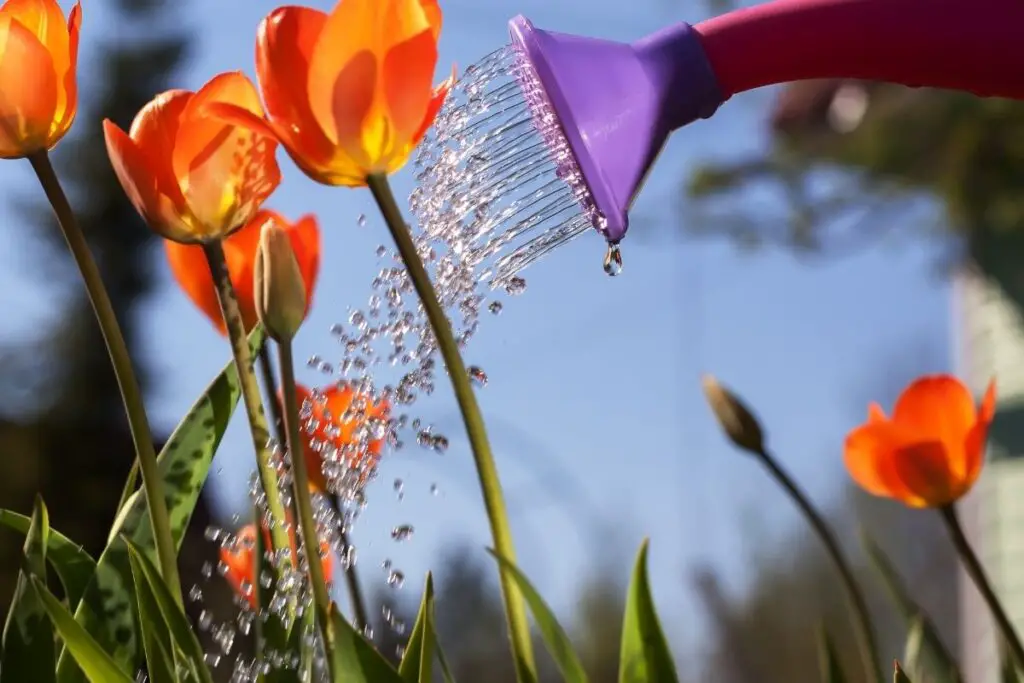
What are the general water requirements for tulips?
Tulips are plants that need minimal watering to thrive. They will need 1 inch of water per week during their growing period.
You should always check the soil before watering your tulips. If you find the topsoil dry at 2 to 3 inches depth, then it would be time to water your tulips. You can also use a moisture meter to measure the moisture level of the soil. It will help you to know about the optimum soil moisture level for tulips.
There is a technique to determine the water requirements for tulips. Here you need to observe the initial drooping effects on the leaves of your tulip plant.
First, you should water the plant thoroughly and observe them for a couple of days. Figure out the day when their lower leaves start to droop, and next time, water them less and test again.
In this way, you will find out the optimum water requirements for tulips within a couple of tries. This technique is known as the layman’s technique which works out great for garden plants like tulips.
Things to keep in mind
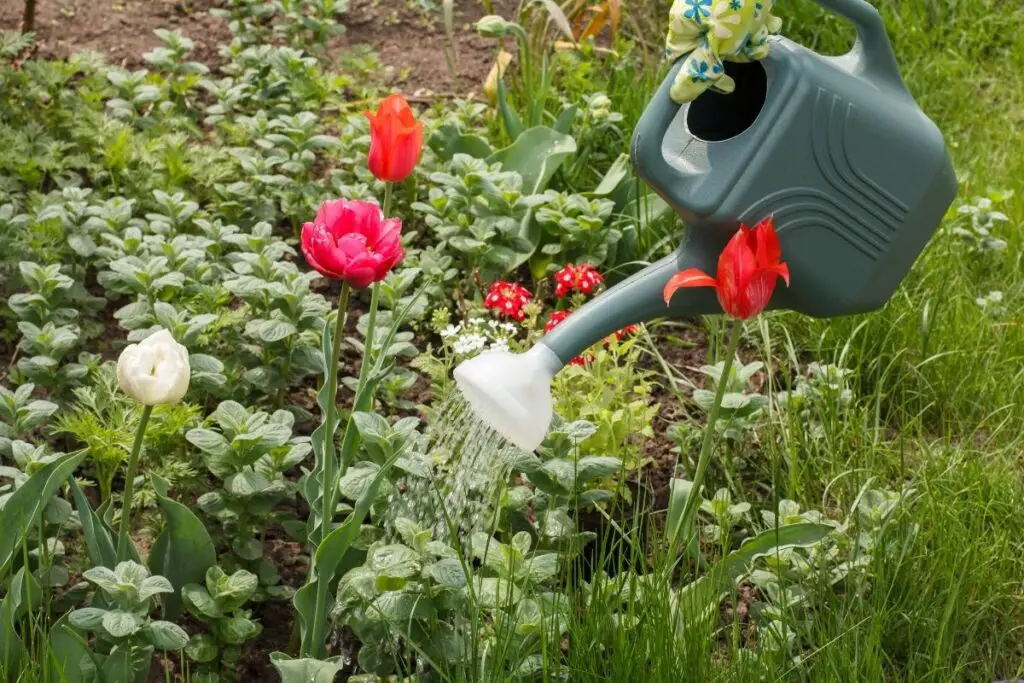
Some factors will influence the watering requirements for your tulip plant:
Light
Sunlight plays a vital role in determining the watering requirements for your tulips. You should plant them in an area with plenty of direct sunlight and make sure the spot has a well-draining, dry, or sandy soil composition.
Tulips are sensitive to root rot problems. If they won’t get proper sunlight, then the soil will remain moist and will not get dry quickly, which can cause root rot issues to them.
So you need to make sure that they receive enough sunlight throughout the day.
Also read: How Much Sunlight Do Tulips Need? (Tulip Light Needs)
Soil drainage
The correct soil preparation can primarily help the soil drain and ensure fresh tulip bulbs in springs. Tulips prefer a well-draining sandy or loamy soil with a mix of organic matter.
If the clay content is more in your garden soil, add sand, sawdust, compost, and humus-rich substance, which will help the soil around the tulips stay loose and drain excess water, which protects the bulbs.
Looking for gardening supplies? We have tested 100's of products before recommending them to you guys. Check out our best pick below:
| Image | Gardening Supplies | Best Price? |
|---|---|---|
 Top
Top Top
Top | Raised Garden Bed Kit | Check On Amazon |
 | XLUX Soil Moisture Meter, Plant Water Monitor, Soil Hygrometer Sensor for Gardening, Farming, Indoor and Outdoor Plants, No Batteries Required | No Results |
 Top
Top Top
Top | 82 Pcs Garden Tools Set and Extra Succulent Tools Set | Check On Amazon |
 | Joeys Garden Expandable Garden Hose with 8 Function Hose Nozzle, Lightweight Anti-Kink Flexible Garden Hoses, Extra Strength Fabric with Double Latex Core, (50 FT, Black) | No Results |
 Top
Top Top
Top | Dual Chamber Compost Tumbler | Check On Amazon |
 Top
Top Top
Top | Sunnyglade Plant Stakes | Check On Amazon |
 Top
Top Top
Top | Organic Cold Pressed Neem Seed Oil | Check On Amazon |
 Top
Top Top
Top | Mighty Mint Gallon :-Insect and Pest Control Peppermint Oil | Check On Amazon |
 Top
Top Top
Top | Scotts DiseaseEx Lawn Fungicide | Check On Amazon |
 Top
Top Top
Top | Jacks Classic 20-20-20 All Purpose Fertilizer | Check On Amazon |
 Top
Top Top
Top | 30,000 Seeds Pollinator Attracting Wildflower Mixture | Check On Amazon |
 Top
Top Top
Top | Survival Vegetable Seeds Garden Kit-Over 16,000 Seeds | Check On Amazon |
Humidity
Tulips grow better in dry places rather than humid regions. If they face high humidity around them accompanied by lots of rain, this may lead the roots of tulips to rot.
You should maintain a little drier conditions for them. If you stay in a high humid region, water your tulips often less than average, do adequate plant spacing and keep them in well-drained soil.
Temperature
Tulips require 12 to 16 weeks of chilled temperature below 55°F to bloom. They need a maximum amount of watering in the growing season, in late winters and early springtime.
Water them once a week to ensure that the soil is holding enough moisture. Their water requirements will reduce when fall approaches and when the blooming period ends.
When should you water your tulip bulbs?
Tulips are spring bloomers, and the water requirements for tulips will vary according to the different seasons and conditions. Here are some tips are given below to find out when to water tulips.
- Water your tulip bulbs deeply after planting, and remember if the bulbs are planted 6” deep in the soil, then water needs to soak in 6” deep in the soil to benefit the bulbs.
- Water them again before the wintertime arrives as this is the time when they are developing roots.
- Water is needed in late winters and the early spring when the bulb has started growing, and so you should water them once a week if you haven’t had any rain. At this time, they will require about 17mm of water per week.
- You should continue watering them once a week until the foliage of tulips dies back.
- Do not water your tulip plant in the summers when they are in a dormant state.
How much water is required once tulips stop blooming?
Tulips will not require much water when it has stopped blooming. Only 1 or 2 inches of water per week will be enough to keep them alive.
They need more watering in the growing season to help the bulb grow bigger and store as much moisture as possible.
If you want to store the tulip bulbs for the next season, you should reduce watering when the tulips start wilting at the end of the flowering season.
You should not water them for at least two weeks. You should cut the flowers head off, then leave the foliage and stems to dry.
This will force them to be in shock, and they will get ready for the transition phase. This shock will help your tulips to preserve their resources for the favorable climate to grow back.
They will become dormant and alive until you grow them back again in favorable spring conditions.
Leaving the plant to get dry allows nutrients from the stem to drain and energize the tulip bulb, allowing them to prepare and store energy for flowering next year.
A simple watering change can help you to preserve tulips for regrowth and transplantation.
What are the techniques of watering a tulip plant?
There are two ways of watering a tulip plant, i.e., shallow watering and deep watering.
If the soil has an optimum moisture content, you should not worry about frequent watering, and you should go for deep watering, which is better for growing in good soil conditions.
The shallow watering technique is helpful in adverse soil conditions. If the soil doesn’t have a sound drainage system, you need to regulate the watering schedule.
Too wet or too dry soil can load up on your watering schedule.
If such cases happen, you may have to repeat watering twice or thrice per weak with a very light soil composition. Or you have to wait for 10 to 15 days for the soil to dry out before the next watering.
You can adapt a drip watering system. It is a technique to regulate between deep and shallow watering wherever required with much manual effort.
In a drip watering system, you need drips to be placed carefully near root balls of tulips at a specific depth, and the rest of the work will be managed by the regulator itself.
This system will ease the task of watering at a one-time installation.
How to water bulbs in pots?
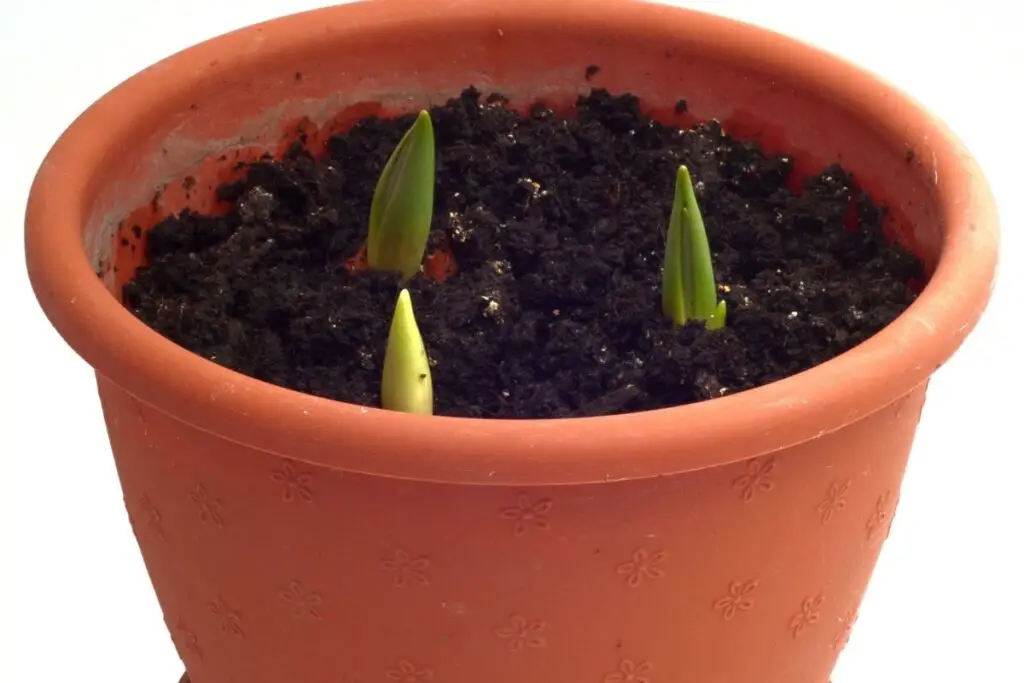
Growing in pots can be stressful for your tulips, so it’s crucial to water them correctly when they are growing inside pots.
Container-grown tulips will require more water than garden tulips because the planting soil will drain out more quickly than the soil in garden beds, making the conditions drier.
You need to water the potting soil thoroughly while planting your tulips and you shouldn’t let them dry out too quickly. Don’t let the tulips sit in standing water.
In winters, keep the soil moist, water them weekly, and avoid watering if the soil becomes frozen. When spring arrives and bulbs multiply, increase the watering.
Check the soil to see if the top 1 inch of the soil layer is dry or not. If it is dry, add water to keep the soil moist and not muddy as they will rot if they sit in soggy conditions.
Is spraying water good for tulip foliage?
You can spray water mixed with seaweed exacts to feed tulips. You can also use fungicides and pesticides to keep the tulips healthy.
But do not water them unnecessarily with water jets, as that can leave droplets on their leaves. These droplets will encourage pests and bacterial infections.
Avoid watering your tulip plants after sunset. If you water them after sunset, the water will remain on the leaves for a longer time, increasing the growth of pests like aphids, mealybugs, spider mites, and nematodes.
It’s always better to spray tulips in the morning to avoid moisture deposition around the foliage.
What happens if you overwater tulips?
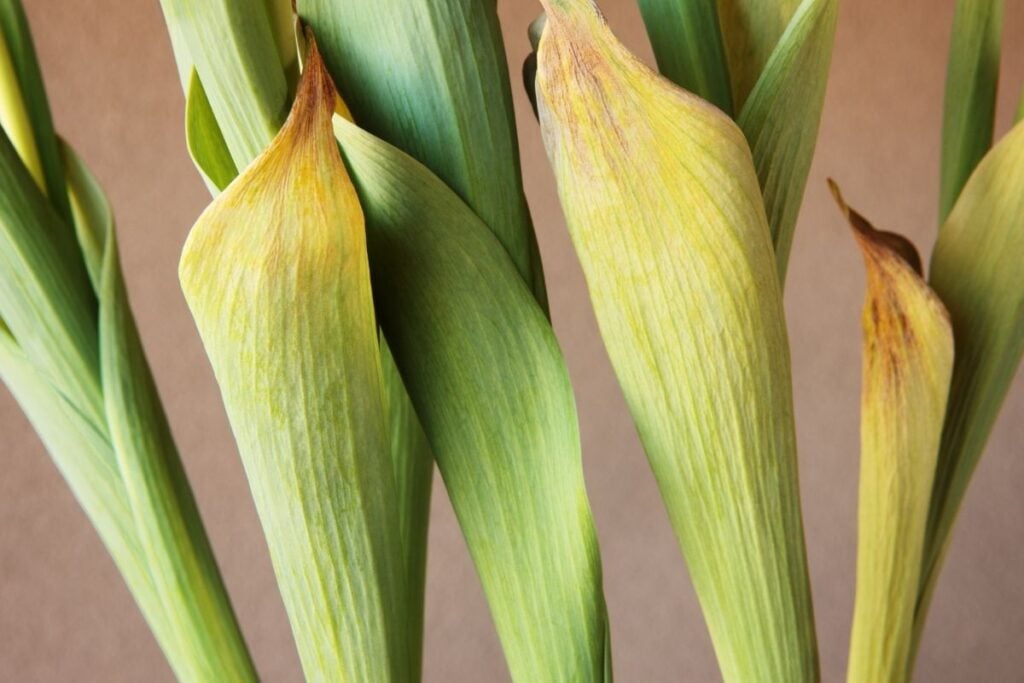
Overwatering can be harmful to your tulips. A tulip can survive a dry spell, but it won’t be able to stand in soggy soil. If you use poor draining soil or allow the water to stand in soil for too long, you are bound to get root rot problems in tulips.
Signs of overwatering are:
- Yellowing of leaves
- Dark brown patches on leaves
- Unusual drooping of leaves
- Discoloration of flower petals
- Increased pest attack
- Root rot in tulips
If you find any of these symptoms when the soil is still wet, immediately stop watering the plant.
How to fix overwatering?
- First, you should leave the plant dry in the sun for a few weeks and heal it naturally.
- Check out the clogged drainage holes of the container or low-lying areas of the garden.
- For containers, you must shift the plant to another container with fresh, dry potting mix.
- For the garden tulips, if the symptoms are severe, you have to transplant them into another location where it is dry to recover quickly.
- Try to grow tulips in at least 8 to 10 inch raised beds.
What happens if you underwater tulips?
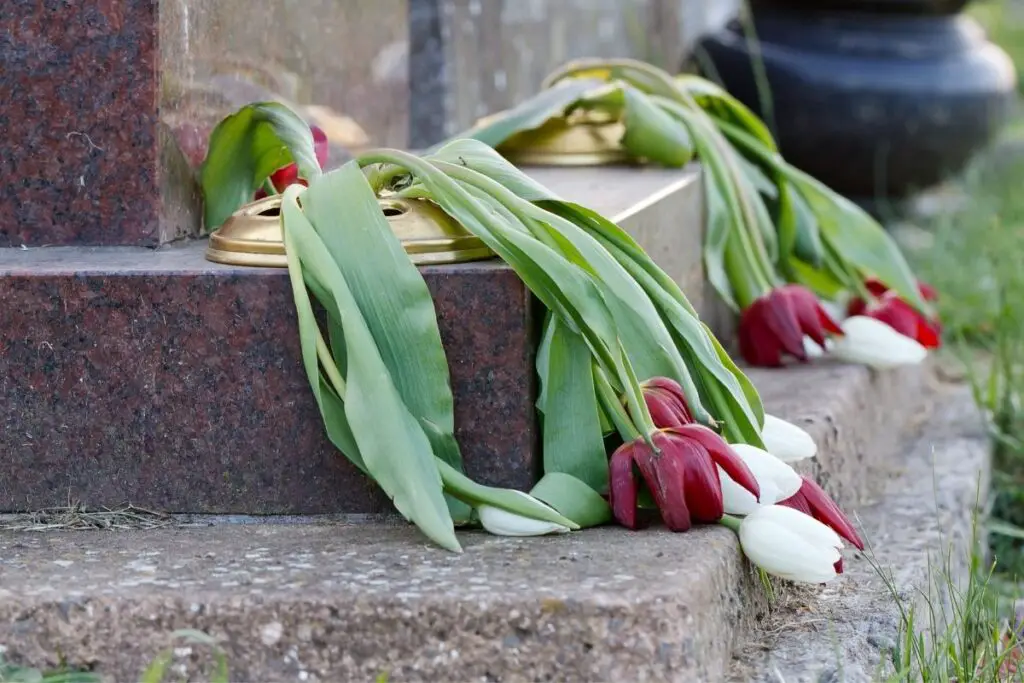
It may happen that you forgot watering tulips for a week or two, and if you do so, particularly in their growing season, it may not be suitable for them. Underwatering can cause the roots to get dehydrated.
Underwatering tulips bulbs have similar effects like overwatering such as:
- Yellow leaves
- Frizzle leaf surface
- Brown patches
- Burning and curling of leaf edges
- Shrinking and dying foliage
- Deformation of the bulbs
How to fix underwatering?
- If you find dry and flaky soil and the leaves becoming small and droopy, understand it’s because of under watering and quickly water your tulips thoroughly.
- Water them regularly, as per the seasons and conditions.
- Tulips don’t like much heat, so you should avoid excess hot conditions for them as this can significantly increase evaporation from the soil. Provide them with some temporary shade in such conditions.
- Prune off their damaged leaves.
Final words
Watering in tulips is easy as this plant doesn’t require your attention every day to water them. They need a minimum of 1 inch of water per week during active growth season.
Tulips won’t require much watering after their blooming season ends. Only ½ inch of water a week will be enough for them. Potted tulips require more watering than garden tulips, and they can need water once or twice a day when they are actively growing.
Make sure that you don’t overwater tulips, especially in the rainy season.
Do not spray water unnecessarily on tulips foliage, as these droplets will increase the chances of pest and fungal infections.
Provide your tulips with adequate watering, plenty of direct sunlight, and well-drained, rich soil to make them flourish.
Source: Wikipedia, North Dakota Stae University, The Royal Horticultural Society.
